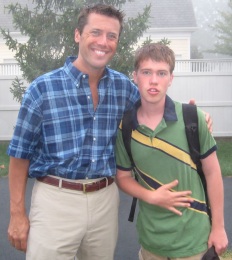
Photos and text used with permission of
Mr. Peter Bell.
When my son Tyler was diagnosed with an autism spectrum disorder (ASD) in 1996, the only reference point my wife and I had for autism was the movie Rain Man. It seemed odd to us... our beautiful three-year old son bore no resemblance to Charlie Babbitt, the character played by Dustin Hoffman. The developmental pediatrician who delivered the diagnosis told us that autism was rare (1 in every 2,500), lifelong, and essentially not treatable. There was no mention of the benefits of behavioral interventions, speech and language sessions, or occupational therapy. She was not interested in hearing about his regression during the prior year, the persistent diarrhea that was obviously causing him a lot of discomfort, or the terrible sleep problems that made all of us function sub-optimally. Our discharge orders read: "Consult your local school district about early intervention." For decades, the medical community has repeated this "goodbye and good luck" prognosis to thousands of families. In a matter of minutes, all our dreams for Tyler were shattered; we were given no reason to believe that he would ever live a life filled with graduations, friendships, or even independence. The one thing the doctor couldn't take away was the intense love and determination we had for our son.
Around the time autism entered our household, a powerful movement was starting to take shape. Parents were starting to question why autism research funding was so meager. The Centers for Disease Control (CDC) had never conducted a surveillance study on the disorder. Sources for private funding were essentially nonexistent. In 1995, two advocacy organizations (Cure Autism Now and the National Alliance for Autism Research), founded by parents who refused to give up, decided to change the paradigm for how the medical establishment viewed autism. They raised money, begged scientists to study the condition, and demanded legislators pay more attention to a new generation of kids growing up with autism. By 2000, the first law to mandate spending on autism research, the Children's Health Act of 2000, was passed. Lawmakers were starting to realize how difficult it was to say "no" to a fiercely determined autism advocate.
The landscape is vastly different today. ASD is now pervasive. Thanks to an incredibly effective national and grass-roots advocacy movement sponsored by organizations like Autism Speaks, the organization for which I work, its status resembles that of AIDS in the 1980s and breast cancer in the 1990s. It is seemingly everywhere - magazine covers, popular TV talk shows, national newspapers, even Presidential candidates include autism in their stump speeches. With the rate of ASD reaching epidemic levels (1 in every 150 children, 1 in 94 boys), the general population is taking notice and asking, "What's going on?" Over 1,500 scientists worldwide are now studying autism. CDC researchers have several ongoing studies to understand why more and more children are being diagnosed with ASD. The United Nations recognizes three diseases with special awareness days: Autism is one of them (AIDS and diabetes are the other two). Clearly, autism has captured the attention of the world.
I am honored to serve on the Integration Panel for the Autism Research Program for the Congressionally Directed Medical Research Programs. It is the one federal research program that takes consumer input seriously. If we are to solve the "autism puzzle" in the near future, there is no question that it will come sooner when scientists and vested stakeholders (i.e., parents) can work together to address the complexity of autism. Tyler turned 16 this year. He's come a long way, just as the autism community has. However, he is still very challenged and will need every major discovery the research community can muster to help him realize his potential. I have no doubt that that day will come during his lifetime.
Last updated Thursday, May 26, 2022














